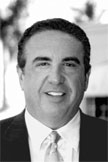| You are here: Home: BCU Nurses 2004 Vol 2 Issue 1: Editor's Note

 |
 |
| Editor’s Note |
 |
| First Communion |
|
Fifty year old Mrs M has always relied on gut instinct when making major life decisions. In 1997, she sought medical care because of a difficult to describe sensation of “just not feeling well.” A CAT scan revealed multiple hepatic lesions compatible with metastases from a breast cancer previously treated with adjuvant chemotherapy, tamoxifen and ovarian ablation.
Not someone to make snap decisions, Mrs M sought several opinions before embarking on a treatment course. The first medical oncologist recommended high-dose chemotherapy and bone marrow transplantation. The second medical oncologist, Dr Charles Vogel, raised the possibility of participating in a clinical trial evaluating a new and unproven but nontoxic treatment utilizing an antibody to a growth factor on the tumor cell surface.
Mrs M’s inner voice told her to trust Dr Vogel, and almost seven years later, she feels totally well in continued partial remission receiving trastuzumab (Herceptin® ) and anastrozole (Arimidex® ).
In the midst of this frightening moment seven years ago, Mrs M learned that she would become a grandmother, and fearing that she might not be alive for her granddaughter’s First Communion, she purchased a rosary to be given to the child in 2004.
“The Communion is this coming May and I’m going be there,” she told me recently with quiet resolve. “I’m going to cry my eyes out, but I’ll be there!” Most oncology health care professionals are frustrated that they can’t do more for their patients, but rays of hope like Mrs M walk into our offices every day, teaching us valuable lessons about science, courage, love and commitment.
The Breast Cancer Update audio series has always emphasized the application of clinical research data into oncology practice. As a medical oncologist, my expertise is not in oncology nursing. However, after 16 years of recording educational audio interviews with physicians, nurses and patients, I have learned a bit about bridging the communication gap that sometimes exists between these key constituents in the cancer crucible.
In addition to providing the perspectives of oncology nurses, this series is designed to present the viewpoints of medical oncologists — from both community-based and research settings — and also give patients a forum in which to be heard. This current issue focuses on the management of estrogen receptor-positive breast cancer and the endocrine interventions that form the foundation of care for patients with these tumors.
The mantra of contemporary oncologic research is “targeted therapy,” which has the potential to be less toxic and more effective than what sometimes seems like the “sledgehammer” approach of chemotherapy. Anastrozole, other endocrine therapy and trastuzumab are perhaps the most cutting-edge targeted breast cancer treatments. All you have to do is look at Mrs M to see the power of these therapies. From her appearance, one would never guess that she was ill — let alone with a condition few patients survive long term.
The clinical courses of the other three women interviewed for this program exemplify the spectrum of endocrine interventions observed in clinical practice. Mrs S, a 67-year-old retired schoolteacher, is currently in the process of receiving five (or more) years of adjuvant anastrozole. This strategy has only been widely embraced in the two years since Dr Michael Baum presented the first results of the massive ATAC trial suggesting that anastrozole might be a better adjuvant choice than tamoxifen for postmenopausal women.
This program includes comments from Dr Baum and Dr Gabriel Hortobagyi, both of whom chronicle the evolution of this exciting therapy. Oncology nurses perhaps have less exposure than oncologists to the ins and outs of sifting through emerging research information like the ATAC trial. However, it is essential that all parties on the interdisciplinary team understand each other’s roles. Hopefully, our program will provide nurses more insight into the thought processes of the oncologists they work with and the way these individuals approach treatment recommendations.
Eighty-year-old Mrs T is another example of the rapid emergence of targeted therapy for breast cancer. She has received two aromatase inhibitors for metastases in multiple bones, and another very high-tech therapy, fulvestrant (Faslodex® ) — the first commercially available “estrogen receptor downregulator.” Like the aromatase inhibitors, this treatment is remarkably nontoxic, although it must be administered monthly via intramuscular injection.
Fulvestrant has antitumor activity that is comparable and perhaps superior to our best endocrine treatments for postmenopausal women (aromatase inhibitors) and also has the unique mechanism of action of obliterating the estrogen receptor, which holds the promise of new potentially more effective treatment strategies. Drs Stephen Jones and Robert Carlson have had key roles in the evolution of this research approach, and in this issue they comment on where this treatment approach is likely to lead.
The other woman interviewed for this issue is Mrs B, an 83-year-old former nurse who has been battling breast cancer for 22 years. After nine years of treatment for metastases she is struggling to maintain a reasonable quality of life. Gasping between breaths during our conversation, she also demonstrated a very refreshing sense of humor. When I asked about her concerns for the future, she quipped, “You mean, am I afraid of dying? Well, no…maybe I’ll go to a better place…a place where I can breathe!”
Mrs B’s oncologist, Dr Sandra Franco, and her oncology nurse, Ms Cynthia Frankel, have obvious enthusiasm for clinical research that will create more miracles like Mrs M attending her granddaughter’s upcoming First Communion. But oncology professionals also know that while the clock may run out on science, there is always a critical role for caring and compassion in confronting what can be, at times, a relentless disease.
—Neil Love, MD
|
